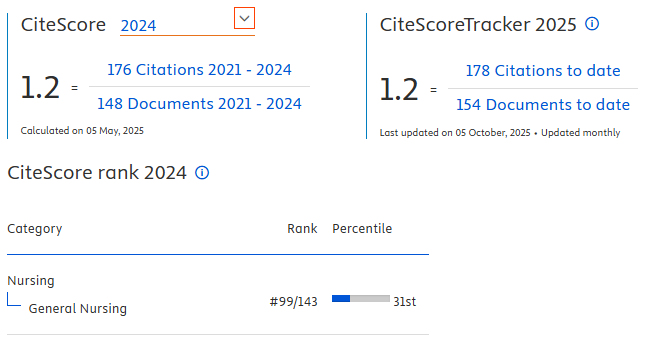Intervensi Keperawatan Truncal Control Exercise terhadap Fungsi Ekstremitas Atas, Keseimbangan, dan Berjalan pada Klien Pascastroke
Downloads
Introduction: Poststroke clients will have impaired postural body that can have affect to their balance, ability to gait and function of the upper limb. Truncal control exercise can improve and maintain body postural be good. Rehabilitation poststroke still focusing on upper and lower limbs exercise of hemiplegia compared postural body's repair.
Methods: This type of research used experimental with quasy control group pretest – postest design. The number of samples obtained with consecutive sampling techniques that appropriate criteria research consists of 20 respondents (n = 10 treatment-and n-control = 10). The independent variable is the truncal control exercise. The dependent variable is the function of the upper limb, balance, and gait. Data were collected by using observation and checklist sheets. Data were analyzed using independent t-test and paired t-test with α = 0,05.
Results: The results of statistical tests performed in the treatment group and the control was obtained p-value of the functional capabilities of the upper limb = 0.270 and p-value of performance of upper limb function = 0.289. The results of statistical tests performed in the treatment group and the control was obtained p-value of balance = 0.017. The results of statistical tests performed in the treatment group and the control was obtained p-value of gait = 0.026.
Discussion: Nursing interventions truncal control exercise have less effective results to changes in upper limb function, but it is effective to balance and walk clients pascastroke. Nursing interventions truncal control exercise can be continued as a form of collaborative action for medical-surgical nurse with physiotherapy to optimize rehabilitation programs of posstroke clients with balance and gait problems in clinic or home's client.
Alghwiri, A.A., 2015. The Correlation between Depression , Balance , and Physical Functioning Post Stroke. Journal of Stroke and Cerebrovascular Diseases, pp.1–5. Available at:
http://dx.doi.org/10.1016/j.jstrokecerebro vasdis.2015.10.022.
Aprile, I. et al., 2006. Predictive variables on disability and quality of life in stroke outpatients undergoing rehabilitation. Neurology Science, 27, pp.40–46.
Bae, S.H. et al., 2013. Effects of Trunk Stabilization Exercises on Different Support Surfaces on the Cross-sectional Area of the Trunk Muscles and Balance Ability. , 25(6), pp.741–745.
Cabanas, R., Cuchi, G.U. & Bagur-Calafat, C., 2013. Trunk training exercises approaches for improving trunk performance and functional sitting balance in patients with stroke: A systematic review. NeuroRehabilitation, 33(4), pp.575–592.
Chung, E.-J. et al., 2013. The effects of core stabilization exercise on dynamic balance and gait function in stroke patients. Journal of physical therapy science, 25(7), pp.803–6. Available at: http://www.pubmedcentral.nih.gov/article render.fcgi?artid=3820398&tool=pmcentrez&rendertype=abstract.
Depkes RI, 2014. Riset Kesehatan Dasar (RISKESDAS) 2013, Jakarta: Badan Penelitian dan Pengembangan Kesehatan. Available at: www.depkes.go.id.
Feigin, V.L. et al., 2009. Worldwide stroke incidence and early case fatality reported in 56 population-based studies: a systematic review. The Lancet Neurology, 8(4), pp.355–369. Available at: http://dx.doi.org/10.1016/S14744422(09)70025-0.
Gjelsvik, B., 2014. Trunk Control in Stroke : Aspects of Measurement, relation to brain lesion, and change after rehabilitation. , pp.1–104.
Herdman, T.H. (Ed) & Kamitsuru, S. (Ed), 2014. NANDA International nursing diagnoses: definitions and classification 2015-2017. Nursing diagnoses 2015-2017 : definitions and classification.
Irfan, M., 2012. Fisioterapi Bagi Insan Stroke 1st ed., Yogyakarta: Graha Ilmu.
Jang, S.H., 2007. A review of motor recovery mechanisms in patients with stroke. Neuro Rehabilitation, 22, pp.253–259.
Karatas, M. et al., 2004. Trunk Muscle Strength in Relation to Balance and Functional Disability in Unihemispheric Stroke Patients. American Journal of Physical Medicine & Rehabilitation, 83(2), pp.81–87. Available at:
http://content.wkhealth.com/linkback/ope nurl?sid=WKPTLP:landingpage&an=000 02060-200402000-00001.
Karthikbabu, S. et al., 2011. Role of Trunk Rehabilitation on Trunk Control, Balance and Gait in Patients with Chronic Stroke: A Pre-Post Design. Neuroscience & Medicine, 02(02), pp.61–67.
Kilinç, M. et al., 2016. The Effects of Bobathbased trunk exercises on trunk control, functional capacity, balance, and gait: a pilot randomized controlled trial. Stroke Rehabilitation, 23(1), pp.50–58. Available at: http://www.tandfonline.com/doi/abs/10.1 179/1945511915Y.0000000011#.V6iGsh KxhU8.
Kim, Y., Kim, E. & Gong, W., 2011. The Effects of Trunk Stability Exercise Using PNF on the Functional Reach Test and Muscle Activities of Stroke Patients. Journal of Physical Therapy Science, 23, pp.699–702.
Kowalak, J.P., Welsh, W. & Mayer, B., 2011. Buku Ajar Patofisiologi R. Komalasari, A. O. Tampubolon, & M. Ester, eds., Jakarta: EGC.
Lalonde, R. & Strazielle, C., 2007. Brain regions and genes affecting postural control. Progress in neurobiology, 81(1), pp.45–60. Available at: http://www.sciencedirect.com/science/art icle/pii/S0301008206001407.
Mauk, K.L., 2006. Nursing Interventions Within The Mauk Model Of Poststroke Recovery. Rehabilitation Nursing, 31(6), pp.257–264. Available at: http://myaccess.library.utoronto.ca/login? url=http://search.ebscohost.com/login.asp x?direct=true&db=cin20&AN=20092865 55&site=ehost-live.
Michaelsen, S.M. et al., 2001. Effect of Trunk Restraint on the Recovery of Reaching Movements in Hemiparetic Patients. the American Heart Association. Available at: http://stroke.ahajournals.org.
Miyake, Y. et al., 2013. Core exercises elevate trunk stability to facilitate skilled motor behavior of the upper extremities. Journal of Bodywork and Movement Therapies, 17, pp.259–265.
Mozaffarian, D. et al., 2015. AHA Statistical Update Heart Disease and Stroke Statistics ” 2015 Update A Report From the American Heart Association WRITING GROUP MEMBERS,
National Stroke Association, 2015. Impact Of Stroke - Women and Stroke. Available at: http://www.stroke.org/understandstroke/impact-stroke/women-and-stroke.
Price, S.A. & Wilson, L.M., 2006. Patofisiologi: Konsep Klinis Proses-Proses Penyakit Edisi 6 Volume 2 6th ed., Jakarta: EGC.
Rai, R.K. et al., 2014. Efficacy of Trunk Rehabilitation and Balance Training On Trunk Control, Balance and Gait in Post Stroke Hemiplegic Patients : A Randomized Controlled Trial. Journal of Nursing and Health Science, 3(3), pp.27– 31.
Saeys, W. et al., 2012. Randomized Controlled Trial of Truncal Exercises Early After Stroke to Improve Balance and Mobility. NeuroRehabilitation and Neural Repair, 26(3), pp.231–238.
Takeuchi, N. & Izumi, S.I., 2013. Rehabilitation with poststroke motor recovery: A review with a focus on neural plasticity. Stroke Research and Treatment, 2013.
Verheyden, G. et al., 2009. Additional Exercises Improve Trunk Performance After Stroke: A Pilot Randomized Controlled Trial. NeuroRehabilitation and Neural Repair, 23, pp.281–286. Available at: http://nnr.sagepub.com.
Verheyden, G. et al., 2006. Trunk performance after stroke and the relationship with balance , gait and functional ability. Clinical Rehabilitation, 11, pp.451–458.
Wee, S.K. et al., 2015. Effect of Trunk Support on Upper Extremity Function in People With Chronic Stroke and People Who Are Healthy. Physical Therapy Journal, 95(August), pp.1163–1171.
Weerdesteyn, V. et al., 2008. Falls in individuals with stroke. Journal of Rehabilitation Research & Development, 45(8), pp.1195–1213.
Authors who publish with Jurnal Ners agree to the following terms:
- Authors transfer the Copyright and grant Jurnal Ners the right of first publication with the work simultaneously licensed under a Creative Commons Attribution 4.0 International License that allows others to remix, adapt and build upon the work with an acknowledgment of the work's authorship and of the initial publication in Jurnal Ners.
- Authors are permitted to copy and redistribute the journal's published version of the work (e.g., post it to an institutional repository or publish it in a book), with an acknowledgment of its initial publication in Jurnal Ners.
Jurnal Ners requires a formal written declaration and transfer of copyright from the author(s) for each article published. We, therefore, ask you to complete and return this form, retaining a copy for your own records. Your cooperation is essential and appreciated. Any delay will result in a delay in publication. The form can be downloaded HERE.
































